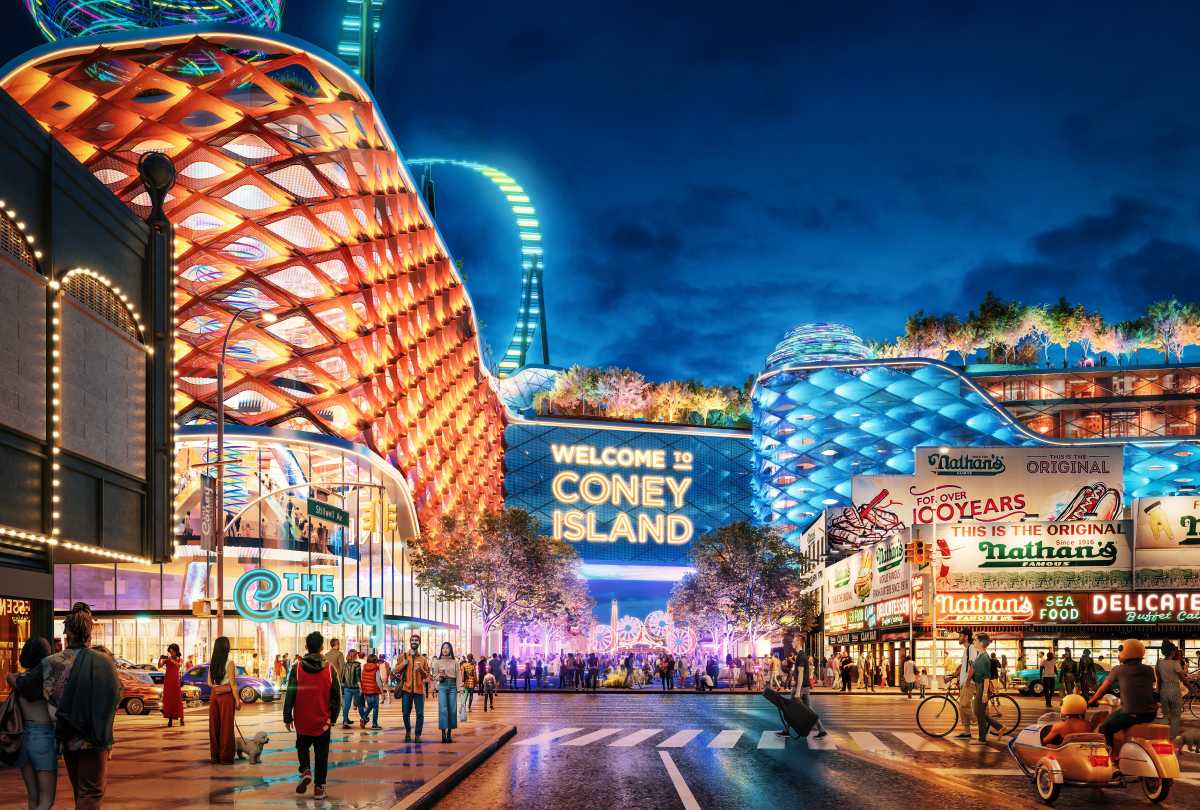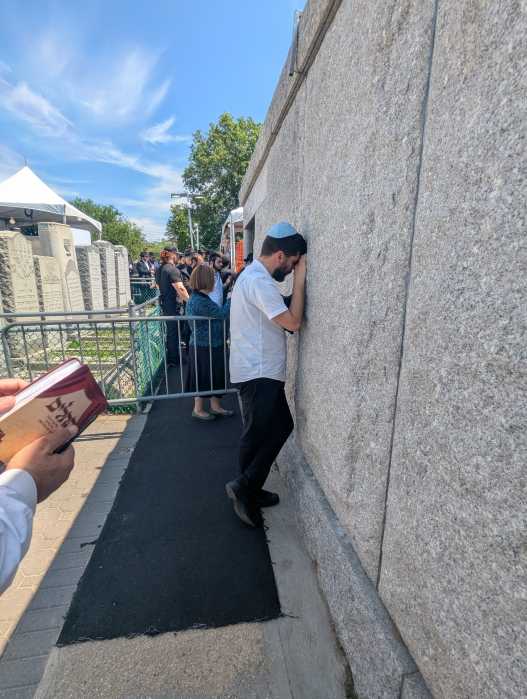By Lincoln Anderson
As the number of meat businesses in the Meat Market continues to shrink to an ever-smaller core, speculation continues about how much longer the industry will last in the area to which it gives its name.
As property values have skyrocketed in the Market, private landlords have raised rents so prohibitively that the meat businesses can no longer afford to stay. Instead, the landlords have leased to nightclubs, restaurants and boutiques, transforming the Market into a thriving new upscale entertainment district.
Today, only about 20 meat businesses remain, down from 150 at the Market’s peak in the 1950s. Ten of these are in the Market’s last bastion, the city-owned co-op building on the block bounded by West, Gansevoort, Little W. 12th and Washington Sts. They have 10 years remaining on their leases.
Another handful of meat businesses are located in a row of coolers — small refrigerated warehouses — along the east side of Washington St. between 13th and Little W. 12th Sts., where the landlord, James Ortenzio, a meat business owner with a soft spot in his heart for them, is renting the spaces for well below market rate. They have two and a half years left on their leases.
A block south on Washington St., the lease of E & S is up and they are moving out soon.
Just two meat businesses are left on W. 14th St.: M & W and Food Warehouse. M & W reportedly is getting offers for its building surpassing the value of its business — meaning it’s a matter of time until they sell out — while Food Warehouse’s lease is expiring soon.
On 13th St., two meat businesses are left, Atlas and Interstate Foods. They both have two years left on their leases and are not fooling themselves into thinking they’ll get renewals.
While all around the neighborhood landlords are cashing in on the Market’s trendy new scene, the co-op building block is protected by a deed restriction for agricultural market use dating from when the Astor family gave it to the city. But elsewhere in the Market, all the meat businesses in privately owned spaces will soon be gone.
“From what I see, it’ll be a very, very small remnant. It’ll just be this block,” said John Jobbagy, owner of his self-named meat company and one of the four directors of the Gansevoort Market co-op building.
Despite dire rumors that the city might at some point want to bring in another market-type use or even eliminate the deed restriction and demolish the two-story co-op building to allow construction of new residential housing, Jobbagy said he’s hearing nothing of the sort from the city.
“They’ve given no indication that they are looking to move us or shorten our lease or anything like that,” he said. “I could not tell you the city’s plans after 10 years. Ten years is a long time, anyway. At this point, who’s to know?”
Jobbagy feels that those owners in the co-op who are in their mid-40s now will probably want to continue in the business for another 10 years after the current lease is up, while those who are a bit older might just decide to call it quits after 2015.
Ortenzio, another director of the co-op and president of Long Island Beef, moved his business out of the Meat Market years ago. As for what he’ll do with his building on Washington St., he says he doesn’t know yet.
“I’ll be the last to make a move,” he said. “I don’t play with people’s lives. I wasn’t the first one who pulled the trigger — I’ll be the last. They have two-and-a-half-year leases. A year from now, I’ll know what I’m doing — because I’ll see what’s happening around here.”
In a year, progress may have been made on two large-scale projects that, once built, would reshape the area further still: the Dia Art Foundation’s plan for a new museum on Gansevoort St. and Andre Balazs’s planned 12-story hotel on Washington St.
The city is very supportive of the Dia plan, but no approvals have been given yet. The museum would require the changing of the deed restriction since it’s on the Astor block and also a variance to allow museum use in the manufacturing-zoned district.
Some meatpackers like the idea of the museum — or at least are not opposed to it. It would be a long, low horizontal structure, mostly on the second-floor level where it would connect with the High Line. Under the plan, the badly water-damaged Meat Market building at 820 Washington St., formerly occupied by Maggio Beef, but empty the last five years, would be demolished to allow creation of an entrance up to the High Line and a ground-floor gallery space for Dia. Dia would build over the other Market building along Gansevoort St., 555 West St. — a former Fire Department high-pressure pump house — where Premier Veal is currently a tenant, which may or may not be demolished under the plan.
Dia says it likes the industrial feel of the Meat Market and wants to have meat businesses below the museum.
However, Interstate Foods, the largest meat business left in the Market, says it had an agreement with the city last fall for the Premier space, but when the Dia museum plan was hatched, the city abruptly stopped talking to them. Interstate needs the space, it says, because its lease will soon be up on 13th St., where construction is also ready to start on Balazs’s hotel. Interstate — which traffics in boxed, or precut, meat — also has space in the co-op building, but there’s no more room in the co-op and private landlords in the Meat Market aren’t renting to meat businesses anymore.
“We had a handshake deal to take the Premier building. We were going to put $1 million in renovations into the building,” said Vincent Pacifico, Interstate vice president. Last month, Interstate wrote Dan Doctoroff, deputy mayor for economic development, for an update, but haven’t heard back since. Likewise, the city’s Economic Development Corporation hasn’t responded to them either, Pacifico said.
“I feel the city doesn’t care about blue-collar workers,” Pacifico said, “that if it wasn’t about the Olympics they didn’t want to talk to you.” Even without a new lease, with cranes across the street and construction on the hotel, they won’t be able to run their business on 13th St., they feel.
Pacifico was not pleased when Ortenzio — who likes the museum plan — told The Villager in May that he wasn’t convinced there should be meat businesses under the museum, noting he didn’t want anything possibly keeping Dia from being a success.
Interstate has two-thirds of its business in the Hunt’s Point Market in the Bronx, now the city’s main meat market, to which many meatpackers from the Meat Market relocated. But they can’t move their 13th St. operation there.
“There is no Bronx. The Bronx is full,” Pacifico said. “We looked in Yonkers, we looked in Bayonne.”
Interstate’s not against the Dia museum, but they don’t want to see it built at the expense of space for the meat businesses.
“I think culture’s great,” added Robert Greenzeig, Interstate’s president. “But you can’t just push people out. We’ve been here 56 years. We have 60 blue-collar workers [in the Meat Market].”
Laura Raicovich, Dia’s director of external affairs, said there’s not much new to report on the project, since things have slowed down for the summer, but that Dia is still committed to keeping meat businesses in the Meat Market — and below the museum.
“Our proposal has always included preserving and improving space available to meat businesses,” she said.
In May, Kate D. Levin, commissioner of the city’s Department of Cultural Affairs, called Dia “an extremely important cultural organization” and its Meat Market museum proposal “intriguing,” noting that it is “sensitive of the community and provides for market-use space.”
Speaking on Tuesday, Jennifer Falk, a mayoral spokesperson, said, “The city will continue to work with the Gansevoort Market tenants, including Interstate Foods, to help them grow and to preserve the neighborhood’s unique character. This neighborhood has a variety of uses and constituencies and we are seeking to balance them in a way that makes sense for everyone.”
Bob Wilkins, owner of Lamb Unlimited, an Ortenzio tenant, said he’s interested in the Premier Veal space, too — “if the space exists.”
Ortenzio has been a great landlord, but who knows what will happen in two or three years, he said.
“We think he’s extremely honorable in every way,” Wilkins said, before adding, “Nobody knows what the future is down here; it changes day to day.”
As Wilkins was standing outside his cooler on Washington St. on Monday about 5:30 in the morning, his pensive mood about the Market’s future was broken, as Frank Ottomanelli, one of his prized customers, walked out pushing a hook hung with racks and legs of lamb suspended from a track on the metal canopy above.
“He’s been on ‘Emeril,’ ” Wilkins said proudly.
“Five times,” chimed in Ottomanelli. His family’s butcher shop on Bleecker St. is rated in the top 10 in the city by Zagat’s. If Wilkins’s business has to leave the Meat Market, Ottomanelli’s not sure what he’d do.
“Well, I’m 61 years old,” Ottomanelli said. “The future, it’s hard to predict. If Bob had to relocate. What I buy is all fresh — what we call ‘hanging meat.’…. I would have to follow him.”
Tom Ventrone, an owner of London Meats and a shareholder in the co-op building, said having the Market in Lower Manhattan is a boon for Manhattan’s restaurant industry, allowing speedy deliveries. He noted how once he had an employee hop on a bike and deliver steaks to Bryant Park Grill and Roth’s steakhouse, while another time his bookkeeper took a subway to drop off a steak at O’Neal’s. He also supplies Tavern on the Green, the Four Seasons and Carmine’s, among others.
Ventrone is strongly against changing the block’s deed restriction to allow the museum, feeling it will open the door to push out the meat co-op.
“I think it’s a way for them to maneuver to get us out of the Market in the future,” he said. “So I’m completely opposed. It could be the beginning of the end.”
For his part, Jobbagy says the Maggio and Premier buildings were never part of the co-op anyway and that they’re the city’s property so it can decide what it wants to do with them. But, while seemingly fairly neutral on the project, he said it could be that an art museum might turn out to be a good fit.
Ortenzio, for one, thinks construction of the Dia museum will take at least three years to complete, so no one should even think about getting the former Premier space until then. Yet, he realizes the hotel will have a significant impact, maybe on the meat businesses he rents to on Washington St. From Interstate to Lamb Unlimited, everyone is wondering where the hotel entrance will go, since that will also be a factor.
“I don’t know if they can operate with a hotel across the street,” Ortenzio said. “I don’t know where the entrance is going to be — or will a headlight be shining into the hotel lobby — or diesel fumes drifting into the [hotel’s] coffee shop.”
Realistically, Ortenzio, who lives in Greenwich Village and notes that he has experience as a planner — he was formerly chairperson of the Hudson River Park Trust — feels it’s time to add residential uses to the Meat Market. The day of the meat businesses is basically gone, and now only rezoning the manufacturing area to allow people to live there can stem the tide of nightlife’s growth, in his view. Buddha Bar, the area’s biggest megaclub yet, may be coming to the Market soon, with more to follow, but residential use would be a counter, Ortenzio insists.
“Whether it’s Buddha Bar, Shinto Bar or Islam Bar — it won’t have an effect, I don’t care,” Ortenzio said. “Having residential there will create another tone in the Meat Market…. It’s time for the Meat Market to become more like Greenwich Village. To me, the sign will be baby carriages on Washington St.”






































